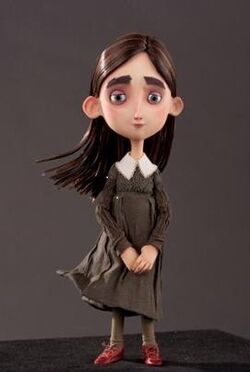| Agatha Prenderghast | |
|---|---|
 | |
| Information | |
| Name: | Agatha Prenderghast |
| Gender | Female |
| Ethnicity | {{{ethnicity}}} |
| Likes | {{{likes}}} |
| Dislikes | {{{dislikes}}} |
| Age | 11 (in the human form) 311 (in the ghost form, actually) |
| Hometown | Blithe Hollow, Massachusetts, USA |
| Family: | {{{relatives}}} |
| Status | Deceased |
| Portrayal | Jodelle Ferland |
| Appeared in | ParaNorman |
Agatha Prenderghast, nicknamed as Aggie, was an alleged witch whose curse haunts Blithe Hollow. She is the main antagonist in the story ParaNorman. Initially introduced as an evil and malevolent witch, she was actually only an innocent little girl. Aggie was accused of witchcraft in 1712, and executed because of her ability to speak to the dead. This caused her to curse the seven judges of her trail in anger.
Overview
Agatha lived with her mother in Blithe Hollow, Massachusetts. Much like her distant relative, Norman Babcock, she can see the dead and also speak to them. Her ability caused people to become more and more distant from her to the point that they were led into believing that she was a witch and the people were led in to taking her away from her mother and was sentenced to be executed by the judge, and was later hanged. Angered at the judges' accusation, as she didn't do anything wrong, Agatha cursed those who testified against her and her curse continued for three hundred years. However, every year, someone, who has the same ability as her, is obliged to read a book to put her to sleep before her curse begins, delaying it by one year. It is presumed that other Prenderghast mediums all the way down to Norman's great-uncle Mr. Prenderghast were the ones that did so.
Throughout the events of her death's 300th anniversary, what had happened to her became famous, but was only believed to be a myth. Due to the stories and circumstances surrounding her death being twisted by the public view, even Norman thought she was evil. However, when he discovered that she was only actually an innocent girl whom was sentenced to death for her ability to speak with the dead, he became disgusted at the cursed seven for their misunderstanding of her ability. The Seven, however, were regretful and that they are disappointed in themselves and are sorry for what they had done to her. The Judge had admitted that he only thought that he was doing what was right, but he was wrong.
At the end, Norman finally faced Agatha, talking some sense into her by telling her story he'd put into his own words after she'd burnt the real book used to put her to sleep. He accused that she was the same as them, that she, too, was a bully. Agatha disagrees, but she later realizes that what Norman had said was exactly the truth. He told her that although they did something awful, it doesn't mean that she should, too. And she has to remember. Not just the bad people, but also the good ones that she'd forgotten. Aggie reminisced to Norman that, before she died, her mother took her to a tree, the same one that she was buried under. There, her mother told her stories that always had happy endings. Aggie was able to find peace that allowed her to finally lift the curse and move on to the afterlife, along with the seven who had wrongfully accused her of witchcraft.
Personality
Aggie is mostly a girl with a sweet, modest demeanor. However, when the judge and his underlings convicted her, her fear and uncertainty gave way to pure hatred and rage, unleashing her power on them. She also despised hearing the story that was being read to her, as she confessed contentment to the book's destruction. She feels that those who have wronged her deserve the same, and she refuses to see her own wrongs, even when Norman is telling them to her. In the end, she learns how to let go of her pain and passes over to the next world, hoping to meet her mother once again.
Physical Appearance
Agatha is depicted through effigies and the school play Norman is in, as a stereotypical old witch with a pointy hat, a long nose (with a noticeable wart on it) and a long chin, she also has a statue with that appearance. However, her real appearance is actually a little girl, whose age is no older than Norman, with long blackish brown hair, pale blue eyes, pale skin, quite thick eyebrows, and wears a dark grey dress with a white collar and red shoes.
Quotes
To Norman
- "I don't want to go to sleep. And you can't make me."
- "I wanted everyone to see how rotten they were!"
- "I burnt the book into dust, now I don't have to hear that story ever again!"
- "Aggie...My name was Aggie..."
- "My mommy brought me here once. We sat under the tree and she told me stories, they all had happy endings, and then those horrible men came and took me away and I never saw her again!"
- "I just want my mommy..."
- "...That story you were telling...how does it end?"
- "I don't like this story!"
To the seven judges
- "Leave me alone or I'll make you sorry! I'll make all of you sorry!"
- "I was only playing..."
Trivia
- Aggie was born in 1701.
- Since she was accused of witchcraft, Aggie and her mother were living in a Puritan village at the time. Puritan villages were hot-spots for witch-hunts during the Witch trial frenzy.
- In an indirect way, Aggie and Norman are related.
- Aggie died in 1712.
- Aggie bears a striking resemblance & similarity to Alessa Gillespie from the Silent Hill franchise. Also, both characters were portrayed by Jodelle Ferland.
- Due to being reformed in the ending as well as her backstory, many viewers think that she is not the main villain and the movie's secondary deuteragonist as well as the secondary villain, leading to many people believing that Judge Hopkins is the true main villain. It's also possible that they thought this due to Judge Hopkins being the only known antagonist that is shown in movie posters, and Aggie herself is vaguely seen (if not counting the witch-like apparitions that she used to scare everyone).


































